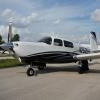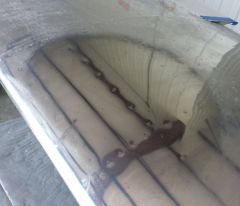-
Posts
268 -
Joined
-
Last visited
-
Days Won
1
Content Type
Profiles
Forums
Blogs
Gallery
Downloads
Events
Store
Everything posted by IndyTim
-
I also have a KAP150. When I said I dial in 1500fpm, I didn't mean that I have an actual VSI preset. I've experimented with this, and know that if I hit ALT (disabling ALT hold) and then hit the AP trim down button and hold for a count of one thousand one, I'm in the ballpark. I just need to know that I've started down to breathable air, and need the simplest, most immediate, CERTAIN way to ensure this. This is the best I've been able to come with, given my equipment ('87 TSE with KAP 150). I'm not worried about what will happen below 10k. Unless I'm over high terrain, and that would require me to rethink my protocol before I fly those types of routes. I'll be in breathable air and back to my senses before I get to 10k. I know that because I've experienced it.
-
Many folks are using the pulse demand O2 systems like the O2D2 from Mountain High. I have one and use it constantly above 12,000. I also carry a backup tank. The tragedy of the Glazers' TBM-900 loss near Cuba made me think hard about O2 use, and to develop a definite protocol in the event of O2 issues of any kind. I was worried that, if I had an O2 interruption at FL220 or 230, that I would lose ability to act rationally. So my protocol is this: in the event of an O2 issue of any kind in Class A, it requires an immediate descent. I would set AP vertical speed to -1400 fpm, THEN notify ATC of the emergency, THEN fiddle with the backup. That way I should be in breathable air in a few minutes, if I lose ability to function. Shortly after I made this decision, I was at FL230 and my pulse system failed. I followed the protocol. Except I was so confused that I asked ATC for "FL120" (heading eastbound) - all I could think was I needed to get to 12000. ATC was incredibly accommodating. I was down at 16000 or so before I got access to O2 again, by bypassing the pulse system. ATC didn't ask if I wanted to declare until I was down to about 15,000, and by then it was ok. They checked in with me again after a few minutes to make sure everythin was ok. As it turned out, the rechargeable batteries I was using had failed. Lesson: just buy new high quality batteries for that system.
-
Mike I agree. I used to fly FL230 or 240 in 252BH. The speed up high, especially heading east, can be seductive. But after 2 different oxygen incidents up high, my max altitude is FL210 now, and alot of my flights are 11000 to 17000.
-
No communication on an IFR plan as he was handed off from center to center? He was capable enough to initiate the descent, but not able to communicate? That doesn't add up. I wonder if it was a comms failure.
-
They were making good ground speed most of the flight. I expect they stayed high for speed and/or clear air, as long as they could. 1600fpm is very doable. Until I saw the timeline I figured this was a normal descent, since it's pretty consistent all the way down to 13400. But now I'm not so sure, because of timing of the comms issues. I wonder if there was some sort of electrical issue, causing radio problems and then instrument failure leading to disorientation in IMC? I'm guessing....
-
I'm still listening to the tape in the background - I assume they were cleared for the descent since it looks normal down to 13,400. And I doubt that there were O2 issues with the normal descent down to breathable air. But from there everything goes bad. Two things that could have caused such a rapid descent from 13,400 would be IMC-related disorientation/spin, or some sort of in-flight breakup. In-flight breakup could be explained by convective activity, I suppose, but since Mooneys are stout it would have to be severe. But a prop issue could result in an engine separation - not an event I'd ever want to experience. Looking at the radio times, ATC attempted to contact 370MM around 2:35 pm and again at 2:38 local time, assuming the tape starts at 2:30pm, with the event (whatever it was) happening at 2:47pm. I'm surprised there isn't more activity around 17:00 on the recording, which is when FlightAware says the flight went down. They would have been on an IFR plan due to wx and altitude -- do ATC systems issue any type of audio or visual alert when an aircraft on an IFR plan significantly deviates from heading/altitude/vs?
-
This is sad. Something happened on the descent, around 13,000, to cause the 5500fpm plummet. Weather-related? Anyone know which ATC feed would have the comms? Is this NY Center?
-

Canada airspace, and RNAV (GNSS) approach
IndyTim replied to IndyTim's topic in Miscellaneous Aviation Talk
Thanks for the pointer Dave. -

Canada airspace, and RNAV (GNSS) approach
IndyTim replied to IndyTim's topic in Miscellaneous Aviation Talk
i don't plan to spend any money other than minimum fuel, and rent on a cabin. At this point I have a policy that if I'm getting taxed then, well, I'll just try not to buy anything. Of course, here in Missouri, that means trying not to own anything taxable either, since we get to pay annual property tax on any asset the gubment can require a decal on.. Including aircraft which bites, big time. I'll spend my week with some cousins in search of trophy walleye. -
Sold, thanks Andrew!
-
-
-
I'm doing a sanity check since I haven't flown in Canadian airspace before. I think I've got everything regarding customs procedures, paperwork, radio/operators license, etc etc all worked out. Regarding instrument approaches, my destination airport has an RNAV (GNSS) approach. I believe that, with Canada data in my GNS430, I can fly an RNAV (GNSS) approach on an ICAO plan since I'm RNAV 1,2 and 5 capable. Am I missing anything? Interestingly, Jeppesen want $170 for a one-time update to add Canada data to my 430, but for $100 they'll bump me from United States to all Americas, for a year. I don't claim I will ever understand Jepp pricing.
-
***** SOLD - no longer available. ******* I have a room in a shared house available. 2 twin beds, wifi available. $675 for the week, or best offer. The house is shared with members of the RedStar pilots group.
-
https://buy.garmin.com/en-US/US/prod527935.html I was not overly impressed with the D2 watch. I thought it was an expensive gimmick, more in-your-face technology looking for a home. But the Bravo is interesting, if also expensive like everything Garmin makes. It's reasonably attractive, looks more like an actual watch than the D2 does, and has some useful functions. I don't think I'd buy one, but would be happy to get one as a gift. As long as it didn't come out of my wallet - somehow the gifts in my family always seem to, but that's another discussion.
-
Those pictures are hard to look at. Lots of love and labor went into building some of those airplanes.
-
Attempt at humor - I fly to or through TX about every week. Lots of wet stuff down there.
-
Wait a minute, I thought TX was a place full of dusty gulches and tumbleweeds.
-
Heading stabilization would certainly be good to have - the 950 is definitely a step up.
-
I've been investigating this mandate and my options for two years. All the vendors tried to scare everyone into making the upgrades early, so as to avoid the hypothetical crush of everyone trying to get into avionics shops at the last minute. Had I acted on that hype cycle, I'd be about $20AMUs poorer right now. My strategy is to hold - new products are coming out constantly and the prices keep coming down. The kicker for me is that I need WAAS plus Mode S since I only have a 430. In the meantime, I have replaced Xm weather with ADS-B from a GDL-39 over a Garmin 796. It isn't as good as XM, but for the price it's good enough.
-
Hank, what are you doing with your scope? I'm interested in improvements in the storm tracking function. Although I was just thinking yesterday, on my flight from Amarillo to Springfield MO, how much I valued my WX-10. It is much better than ADSB WX for providing realtime data about convective activity. *Together* with ADSB, it's a decent method for seeing the big picture and weather system movement combined with reasonably precise storm cell detection.
-
I plow through when I have to, and this year I've had to on almost every trip it seems. But I watch then stormscope carefully, and clear it regularly especially after a change in heading. I stay at least 20 miles, usually more, away from strikes. But if I can, I stay in the clear where I can see what's coming, and work my way around bug cells. Especially if I have passengers since they don't like turbulence in GA planes.
-
It took me a bunch of hours as well. My IFR training was complicated by my working on projects on 4 different regions of the country, so by the time it was all done I had had seven different instructors for the IFR ticket alone. A Mooney and an IFR rating go together like peas and carrots though - hard to do long corss countries and stay VFR all the time, unless you live in the southwest. Except this year - holy smokes it's been crappy.
-
I'm taking the family out to Clovis NM so my son and his fiance can look for a place near Cannon AFB. We will need to stop for fuel and a potty break due to the headwinds. We'll file IFR. Weather between is so-so. Looks like we might be able to pick our way through. Tops are above our practical ceiling of FL220. I usually prefer to swing to the backend/southwest side of systems out here, but all the airportts to the south of this system are predicting LIFR into the evening. Not comfortable with that, with a full plane and nearing sunset. Thinking about picking my way through, north of the system, with a refueling stop west/northwest of Tulsa. I have onboard ADSB WX and the WX-10. Together they are good for avoiding convective activity.



